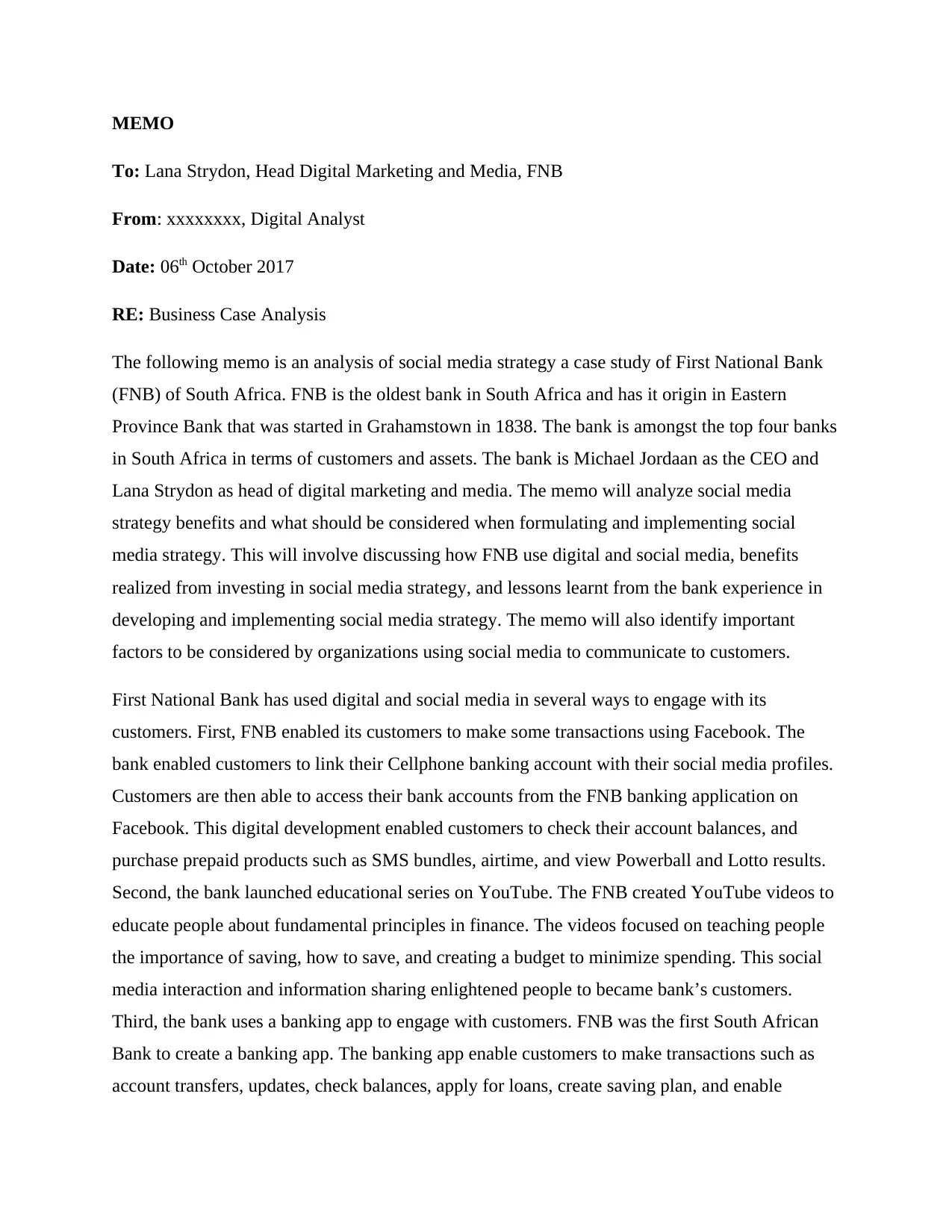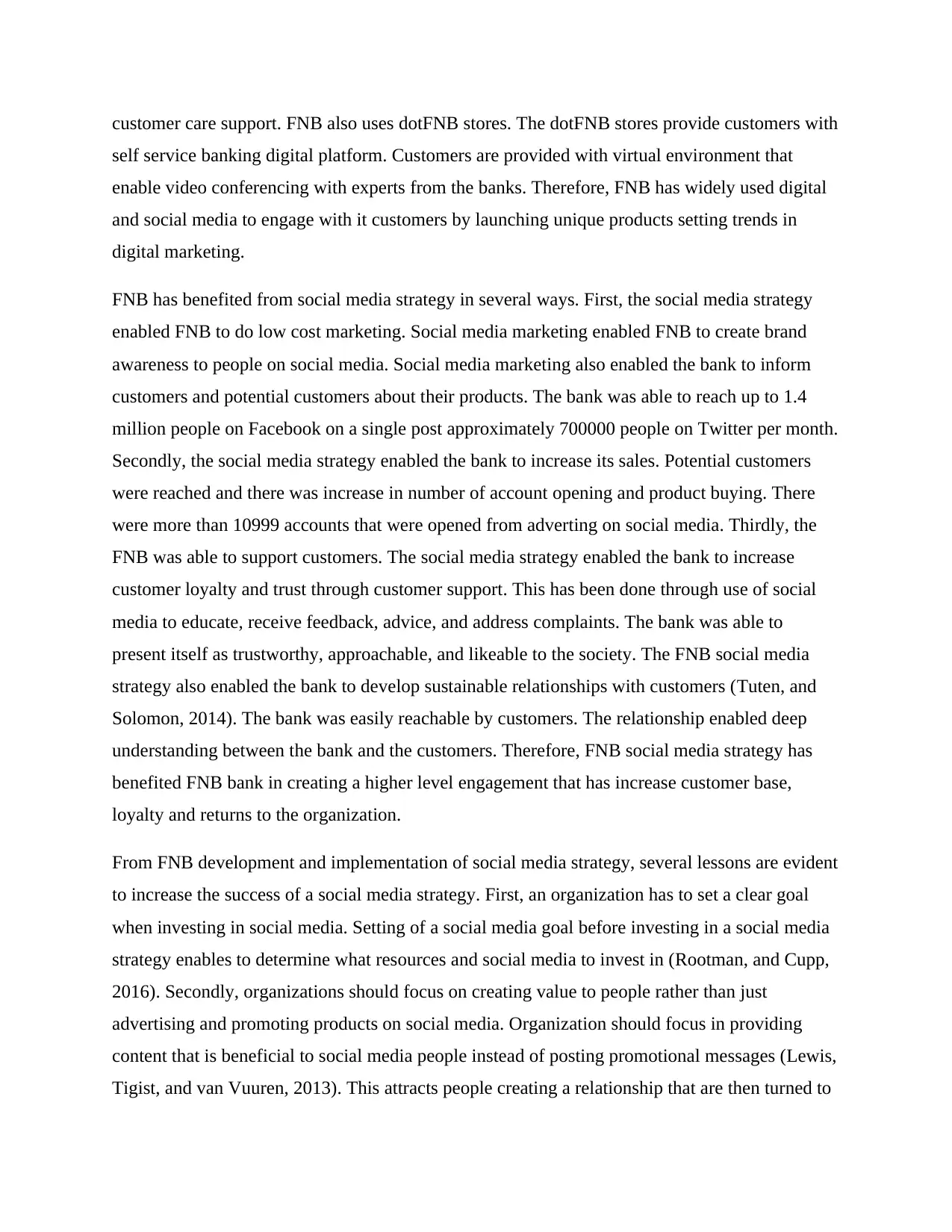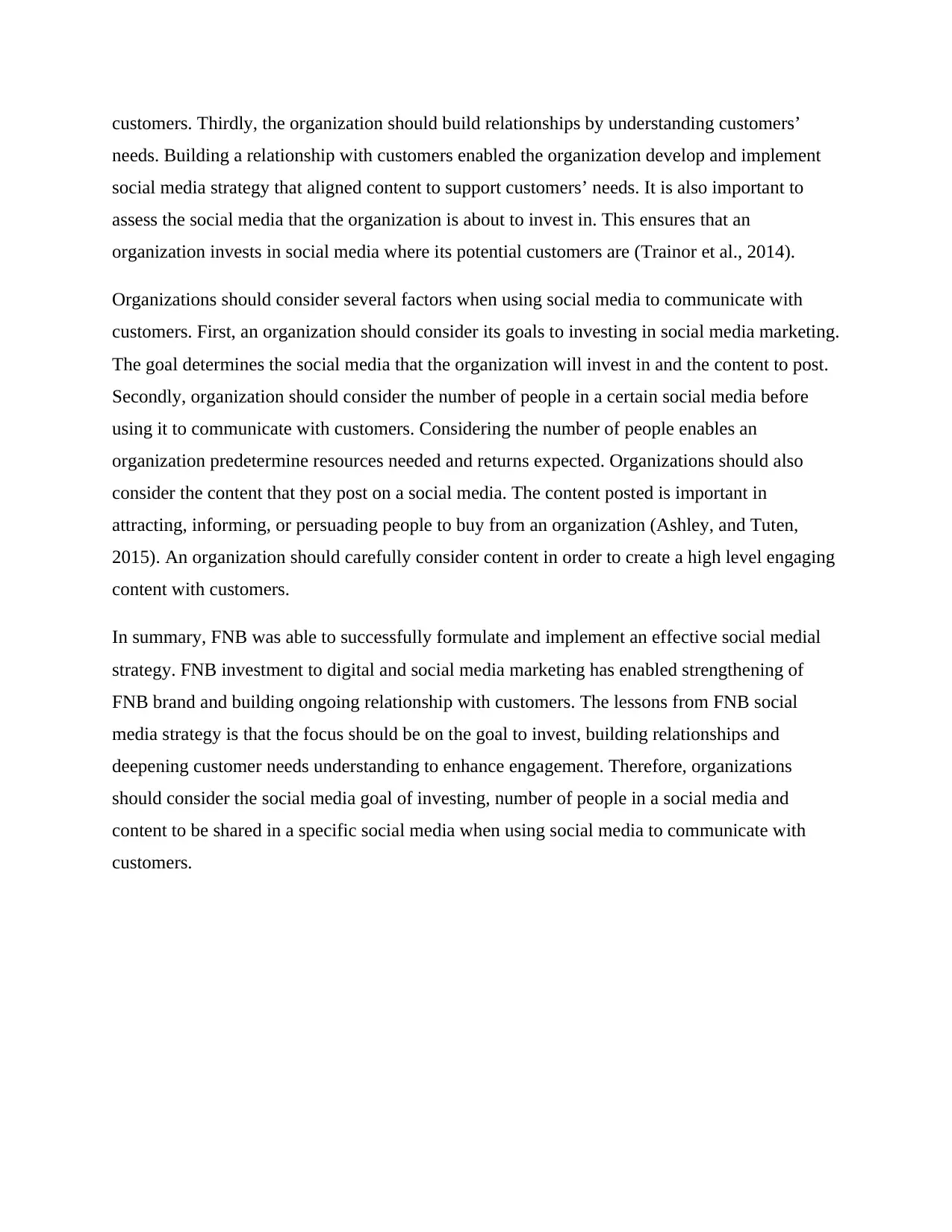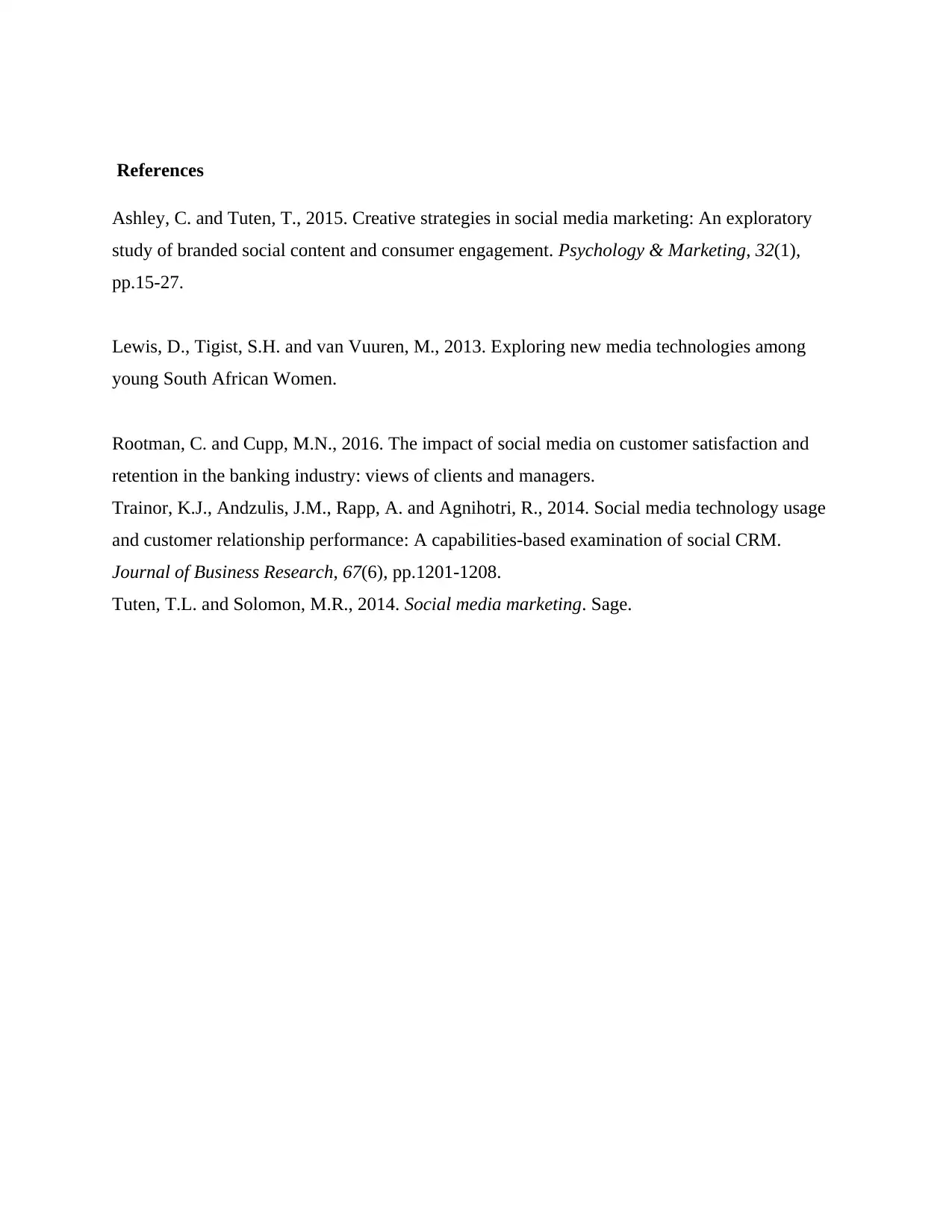Digital Marketing: FNB Social Media Strategy Analysis and Benefits
VerifiedAdded on 2020/03/16
|5
|1359
|78
Report
AI Summary
This report provides a comprehensive analysis of First National Bank (FNB) of South Africa's social media strategy. It examines how FNB utilizes digital and social media platforms, including Facebook, YouTube, and its banking app, to engage with customers. The report highlights the benefits of this strategy, such as low-cost marketing, increased sales, and enhanced customer support. It also discusses the lessons learned from FNB's experience, including the importance of setting clear goals, creating valuable content, building customer relationships, and assessing social media platforms. Furthermore, the report identifies key factors organizations should consider when using social media to communicate with customers, such as their goals, the target audience size, and the content shared. The analysis concludes that FNB successfully formulated and implemented an effective social media strategy, strengthening its brand and building relationships with customers. The report references several academic sources to support its findings and offers valuable insights for businesses looking to leverage social media for marketing and customer engagement. This assignment is available on Desklib, a platform that provides AI-based study tools for students.

UNIT:
NAME:
DATE:
NAME:
DATE:
Paraphrase This Document
Need a fresh take? Get an instant paraphrase of this document with our AI Paraphraser

MEMO
To: Lana Strydon, Head Digital Marketing and Media, FNB
From: xxxxxxxx, Digital Analyst
Date: 06th October 2017
RE: Business Case Analysis
The following memo is an analysis of social media strategy a case study of First National Bank
(FNB) of South Africa. FNB is the oldest bank in South Africa and has it origin in Eastern
Province Bank that was started in Grahamstown in 1838. The bank is amongst the top four banks
in South Africa in terms of customers and assets. The bank is Michael Jordaan as the CEO and
Lana Strydon as head of digital marketing and media. The memo will analyze social media
strategy benefits and what should be considered when formulating and implementing social
media strategy. This will involve discussing how FNB use digital and social media, benefits
realized from investing in social media strategy, and lessons learnt from the bank experience in
developing and implementing social media strategy. The memo will also identify important
factors to be considered by organizations using social media to communicate to customers.
First National Bank has used digital and social media in several ways to engage with its
customers. First, FNB enabled its customers to make some transactions using Facebook. The
bank enabled customers to link their Cellphone banking account with their social media profiles.
Customers are then able to access their bank accounts from the FNB banking application on
Facebook. This digital development enabled customers to check their account balances, and
purchase prepaid products such as SMS bundles, airtime, and view Powerball and Lotto results.
Second, the bank launched educational series on YouTube. The FNB created YouTube videos to
educate people about fundamental principles in finance. The videos focused on teaching people
the importance of saving, how to save, and creating a budget to minimize spending. This social
media interaction and information sharing enlightened people to became bank’s customers.
Third, the bank uses a banking app to engage with customers. FNB was the first South African
Bank to create a banking app. The banking app enable customers to make transactions such as
account transfers, updates, check balances, apply for loans, create saving plan, and enable
To: Lana Strydon, Head Digital Marketing and Media, FNB
From: xxxxxxxx, Digital Analyst
Date: 06th October 2017
RE: Business Case Analysis
The following memo is an analysis of social media strategy a case study of First National Bank
(FNB) of South Africa. FNB is the oldest bank in South Africa and has it origin in Eastern
Province Bank that was started in Grahamstown in 1838. The bank is amongst the top four banks
in South Africa in terms of customers and assets. The bank is Michael Jordaan as the CEO and
Lana Strydon as head of digital marketing and media. The memo will analyze social media
strategy benefits and what should be considered when formulating and implementing social
media strategy. This will involve discussing how FNB use digital and social media, benefits
realized from investing in social media strategy, and lessons learnt from the bank experience in
developing and implementing social media strategy. The memo will also identify important
factors to be considered by organizations using social media to communicate to customers.
First National Bank has used digital and social media in several ways to engage with its
customers. First, FNB enabled its customers to make some transactions using Facebook. The
bank enabled customers to link their Cellphone banking account with their social media profiles.
Customers are then able to access their bank accounts from the FNB banking application on
Facebook. This digital development enabled customers to check their account balances, and
purchase prepaid products such as SMS bundles, airtime, and view Powerball and Lotto results.
Second, the bank launched educational series on YouTube. The FNB created YouTube videos to
educate people about fundamental principles in finance. The videos focused on teaching people
the importance of saving, how to save, and creating a budget to minimize spending. This social
media interaction and information sharing enlightened people to became bank’s customers.
Third, the bank uses a banking app to engage with customers. FNB was the first South African
Bank to create a banking app. The banking app enable customers to make transactions such as
account transfers, updates, check balances, apply for loans, create saving plan, and enable

customer care support. FNB also uses dotFNB stores. The dotFNB stores provide customers with
self service banking digital platform. Customers are provided with virtual environment that
enable video conferencing with experts from the banks. Therefore, FNB has widely used digital
and social media to engage with it customers by launching unique products setting trends in
digital marketing.
FNB has benefited from social media strategy in several ways. First, the social media strategy
enabled FNB to do low cost marketing. Social media marketing enabled FNB to create brand
awareness to people on social media. Social media marketing also enabled the bank to inform
customers and potential customers about their products. The bank was able to reach up to 1.4
million people on Facebook on a single post approximately 700000 people on Twitter per month.
Secondly, the social media strategy enabled the bank to increase its sales. Potential customers
were reached and there was increase in number of account opening and product buying. There
were more than 10999 accounts that were opened from adverting on social media. Thirdly, the
FNB was able to support customers. The social media strategy enabled the bank to increase
customer loyalty and trust through customer support. This has been done through use of social
media to educate, receive feedback, advice, and address complaints. The bank was able to
present itself as trustworthy, approachable, and likeable to the society. The FNB social media
strategy also enabled the bank to develop sustainable relationships with customers (Tuten, and
Solomon, 2014). The bank was easily reachable by customers. The relationship enabled deep
understanding between the bank and the customers. Therefore, FNB social media strategy has
benefited FNB bank in creating a higher level engagement that has increase customer base,
loyalty and returns to the organization.
From FNB development and implementation of social media strategy, several lessons are evident
to increase the success of a social media strategy. First, an organization has to set a clear goal
when investing in social media. Setting of a social media goal before investing in a social media
strategy enables to determine what resources and social media to invest in (Rootman, and Cupp,
2016). Secondly, organizations should focus on creating value to people rather than just
advertising and promoting products on social media. Organization should focus in providing
content that is beneficial to social media people instead of posting promotional messages (Lewis,
Tigist, and van Vuuren, 2013). This attracts people creating a relationship that are then turned to
self service banking digital platform. Customers are provided with virtual environment that
enable video conferencing with experts from the banks. Therefore, FNB has widely used digital
and social media to engage with it customers by launching unique products setting trends in
digital marketing.
FNB has benefited from social media strategy in several ways. First, the social media strategy
enabled FNB to do low cost marketing. Social media marketing enabled FNB to create brand
awareness to people on social media. Social media marketing also enabled the bank to inform
customers and potential customers about their products. The bank was able to reach up to 1.4
million people on Facebook on a single post approximately 700000 people on Twitter per month.
Secondly, the social media strategy enabled the bank to increase its sales. Potential customers
were reached and there was increase in number of account opening and product buying. There
were more than 10999 accounts that were opened from adverting on social media. Thirdly, the
FNB was able to support customers. The social media strategy enabled the bank to increase
customer loyalty and trust through customer support. This has been done through use of social
media to educate, receive feedback, advice, and address complaints. The bank was able to
present itself as trustworthy, approachable, and likeable to the society. The FNB social media
strategy also enabled the bank to develop sustainable relationships with customers (Tuten, and
Solomon, 2014). The bank was easily reachable by customers. The relationship enabled deep
understanding between the bank and the customers. Therefore, FNB social media strategy has
benefited FNB bank in creating a higher level engagement that has increase customer base,
loyalty and returns to the organization.
From FNB development and implementation of social media strategy, several lessons are evident
to increase the success of a social media strategy. First, an organization has to set a clear goal
when investing in social media. Setting of a social media goal before investing in a social media
strategy enables to determine what resources and social media to invest in (Rootman, and Cupp,
2016). Secondly, organizations should focus on creating value to people rather than just
advertising and promoting products on social media. Organization should focus in providing
content that is beneficial to social media people instead of posting promotional messages (Lewis,
Tigist, and van Vuuren, 2013). This attracts people creating a relationship that are then turned to
⊘ This is a preview!⊘
Do you want full access?
Subscribe today to unlock all pages.

Trusted by 1+ million students worldwide

customers. Thirdly, the organization should build relationships by understanding customers’
needs. Building a relationship with customers enabled the organization develop and implement
social media strategy that aligned content to support customers’ needs. It is also important to
assess the social media that the organization is about to invest in. This ensures that an
organization invests in social media where its potential customers are (Trainor et al., 2014).
Organizations should consider several factors when using social media to communicate with
customers. First, an organization should consider its goals to investing in social media marketing.
The goal determines the social media that the organization will invest in and the content to post.
Secondly, organization should consider the number of people in a certain social media before
using it to communicate with customers. Considering the number of people enables an
organization predetermine resources needed and returns expected. Organizations should also
consider the content that they post on a social media. The content posted is important in
attracting, informing, or persuading people to buy from an organization (Ashley, and Tuten,
2015). An organization should carefully consider content in order to create a high level engaging
content with customers.
In summary, FNB was able to successfully formulate and implement an effective social medial
strategy. FNB investment to digital and social media marketing has enabled strengthening of
FNB brand and building ongoing relationship with customers. The lessons from FNB social
media strategy is that the focus should be on the goal to invest, building relationships and
deepening customer needs understanding to enhance engagement. Therefore, organizations
should consider the social media goal of investing, number of people in a social media and
content to be shared in a specific social media when using social media to communicate with
customers.
needs. Building a relationship with customers enabled the organization develop and implement
social media strategy that aligned content to support customers’ needs. It is also important to
assess the social media that the organization is about to invest in. This ensures that an
organization invests in social media where its potential customers are (Trainor et al., 2014).
Organizations should consider several factors when using social media to communicate with
customers. First, an organization should consider its goals to investing in social media marketing.
The goal determines the social media that the organization will invest in and the content to post.
Secondly, organization should consider the number of people in a certain social media before
using it to communicate with customers. Considering the number of people enables an
organization predetermine resources needed and returns expected. Organizations should also
consider the content that they post on a social media. The content posted is important in
attracting, informing, or persuading people to buy from an organization (Ashley, and Tuten,
2015). An organization should carefully consider content in order to create a high level engaging
content with customers.
In summary, FNB was able to successfully formulate and implement an effective social medial
strategy. FNB investment to digital and social media marketing has enabled strengthening of
FNB brand and building ongoing relationship with customers. The lessons from FNB social
media strategy is that the focus should be on the goal to invest, building relationships and
deepening customer needs understanding to enhance engagement. Therefore, organizations
should consider the social media goal of investing, number of people in a social media and
content to be shared in a specific social media when using social media to communicate with
customers.
Paraphrase This Document
Need a fresh take? Get an instant paraphrase of this document with our AI Paraphraser

References
Ashley, C. and Tuten, T., 2015. Creative strategies in social media marketing: An exploratory
study of branded social content and consumer engagement. Psychology & Marketing, 32(1),
pp.15-27.
Lewis, D., Tigist, S.H. and van Vuuren, M., 2013. Exploring new media technologies among
young South African Women.
Rootman, C. and Cupp, M.N., 2016. The impact of social media on customer satisfaction and
retention in the banking industry: views of clients and managers.
Trainor, K.J., Andzulis, J.M., Rapp, A. and Agnihotri, R., 2014. Social media technology usage
and customer relationship performance: A capabilities-based examination of social CRM.
Journal of Business Research, 67(6), pp.1201-1208.
Tuten, T.L. and Solomon, M.R., 2014. Social media marketing. Sage.
Ashley, C. and Tuten, T., 2015. Creative strategies in social media marketing: An exploratory
study of branded social content and consumer engagement. Psychology & Marketing, 32(1),
pp.15-27.
Lewis, D., Tigist, S.H. and van Vuuren, M., 2013. Exploring new media technologies among
young South African Women.
Rootman, C. and Cupp, M.N., 2016. The impact of social media on customer satisfaction and
retention in the banking industry: views of clients and managers.
Trainor, K.J., Andzulis, J.M., Rapp, A. and Agnihotri, R., 2014. Social media technology usage
and customer relationship performance: A capabilities-based examination of social CRM.
Journal of Business Research, 67(6), pp.1201-1208.
Tuten, T.L. and Solomon, M.R., 2014. Social media marketing. Sage.
1 out of 5
Related Documents
Your All-in-One AI-Powered Toolkit for Academic Success.
+13062052269
info@desklib.com
Available 24*7 on WhatsApp / Email
![[object Object]](/_next/static/media/star-bottom.7253800d.svg)
Unlock your academic potential
Copyright © 2020–2025 A2Z Services. All Rights Reserved. Developed and managed by ZUCOL.





